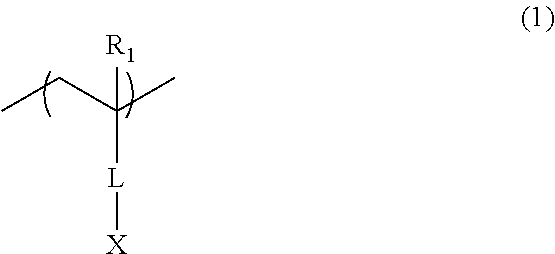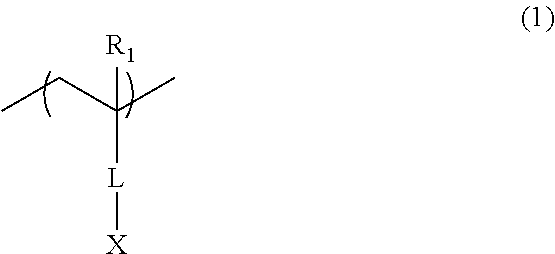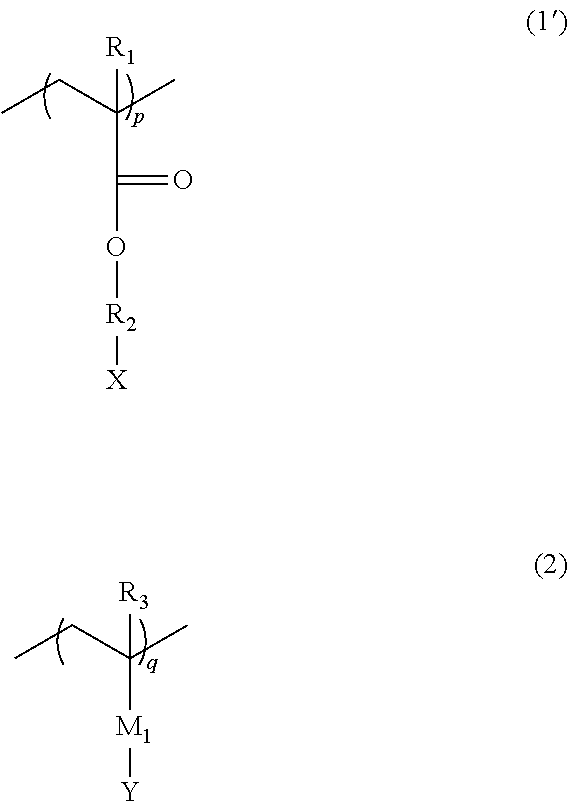Additive for resist underlayer film-forming composition and resist underlayer film-forming composition containing the same
a technology of underlayer film and additive, which is applied in the direction of semiconductor devices, solid-state devices, semiconductor/solid-state device details, etc., can solve the problem that the lactone structure contained in the resist underlayer film-forming composition as a structural component does not sufficiently prevent the collapse of a resist pattern, and achieve the effect of reducing the collapse of a formed resist pattern
- Summary
- Abstract
- Description
- Claims
- Application Information
AI Technical Summary
Benefits of technology
Problems solved by technology
Method used
Image
Examples
synthesis example 1
[0039]14.00 g of diglycidyl 1,4-terephthalate (the product name: EX-711 [registered trademark], Nagase ChemteX Corporation), 8.08 g of isophthalic acid, 0.90 g of ethyltriphenyl phosphonium bromide, and 91.94 g of propylene glycol monomethyl ether were mixed, and the mixture was heated to reflux for 4 hours with stirring to obtain a polymer solution. To this solution, 23 g of a cation exchange resin (the product name: DOWEX [registered trademark] 550A, Muromachi Technos Co., Ltd.) and 23 g of an anion exchange resin (the product name: Amberlite [registered trademark] 15JWET, Organo Corporation) were added, and the mixture was subjected to an ion exchange process at room temperature for 4 hours. A GPC analysis showed that the weight average molecular weight of the obtained polymer was 25,000 in terms of standard polystyrene. The polymer obtained in this Synthesis Example was equivalent to a resin binder contained in a resist underlayer film-forming composition of the present inventio...
synthesis example 2
[0040]152.44 g of propylene glycol monomethyl ether was added to 2.67 g of azobisisobutyronitrile, and heated to 80° C. Into the heated solution, a mixed solution of 37.00 g of glycidyl methacrylate, 10.94 g of trifluoroethyl methacrylate, and 50.00 g of propylene glycol monomethyl ether was gradually added dropwise, and the resultant mixture was reacted at 80° C. for 17 hours to obtain a polymer solution. A GPC analysis showed that the weight average molecular weight of the obtained polymer was 6,200 in terms of standard polystyrene, and the epoxy value of the polymer solution was 1.04 eq / kg. The polymer obtained in this Synthesis Example was equivalent to an intermediate to synthesize a copolymer for an additive according to the present invention.
synthesis example 3
[0041]168.86 g of propylene glycol monomethyl ether was added to 2.89 g of azobisisobutyronitrile, and heated to 80° C. Into the heated solution, a mixed solution of 40.00 g of glycidyl methacrylate, 11.83 g of trifluoroethyl methacrylate, and 50.00 g of propylene glycol monomethyl ether was gradually added dropwise, and the resultant mixture was reacted at 80° C. for 14 hours to obtain a polymer solution. A GPC analysis showed that the weight average molecular weight of the obtained polymer was 7,000 in terms of standard polystyrene, and the epoxy value of the polymer solution was 0.88 eq / kg. The polymer obtained in this Synthesis Example was equivalent to an intermediate to synthesize a copolymer for an additive according to the present invention.
PUM
| Property | Measurement | Unit |
|---|---|---|
| thickness | aaaaa | aaaaa |
| thickness | aaaaa | aaaaa |
| temperature | aaaaa | aaaaa |
Abstract
Description
Claims
Application Information
 Login to View More
Login to View More - R&D
- Intellectual Property
- Life Sciences
- Materials
- Tech Scout
- Unparalleled Data Quality
- Higher Quality Content
- 60% Fewer Hallucinations
Browse by: Latest US Patents, China's latest patents, Technical Efficacy Thesaurus, Application Domain, Technology Topic, Popular Technical Reports.
© 2025 PatSnap. All rights reserved.Legal|Privacy policy|Modern Slavery Act Transparency Statement|Sitemap|About US| Contact US: help@patsnap.com



